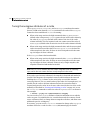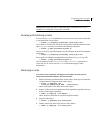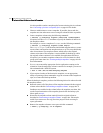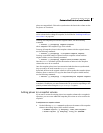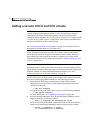
349Administering volume snapshots
Creating traditional third-mirror break-off snapshots
creating the snapshot mirror is long in contrast to the brief amount of time
that it takes to create the snapshot volume.
The online backup procedure is completed by running the vxassist snapshot
command on a volume with a SNAPDONE mirror. This task detaches the
finished snapshot (which becomes a normal mirror), creates a new normal
volume and attaches the snapshot mirror to the snapshot volume. The
snapshot then becomes a normal, functioning volume and the state of the
snapshot is set to ACTIVE.
To back up a volume using the vxassist command
1 Create a snapshot mirror for a volume using the following command:
# vxassist [-b] [-g diskgroup] snapstart [nmirror=N] volume
For example, to create a snapshot mirror of a volume called voldef, use the
following command:
# vxassist [-g diskgroup] snapstart voldef
The vxassist snapstart task creates a write-only mirror, which is attached
to and synchronized from the volume to be backed up.
Note: By default, VxVM attempts to avoid placing snapshot mirrors on a
disk that already holds any plexes of a data volume. However, this may be
impossible if insufficient space is available in the disk group. In this case,
VxVM uses any available space on other disks in the disk group. If the
snapshot plexes are placed on disks which are used to hold the plexes of
other volumes, this may cause problems when you subsequently attempt to
move a snapshot volume into another disk group as described in “Moving
DCO volumes between disk groups” on page 200. To override the default
storage allocation policy, you can use storage attributes to specify explicitly
which disks to use for the snapshot plexes. See “Creating a volume on
specific disks” on page 244 for more information.
If you start
vxassist snapstart in the background using the -b option, you
can use the
vxassist snapwait command to wait for the creation of the
mirror to complete as shown here:
# vxassist [-g diskgroup] snapwait volume
If vxassist snapstart is not run in the background, it does not exit until
the mirror has been synchronized with the volume. The mirror is then
ready to be used as a plex of a snapshot volume. While attached to the
original volume, its contents continue to be updated until you take the
snapshot.
Use the nmirror attribute to create as many snapshot mirrors as you need
for the snapshot volume. For a backup, you should usually only require the
default of one.








